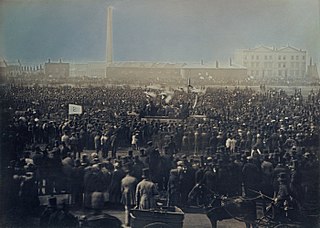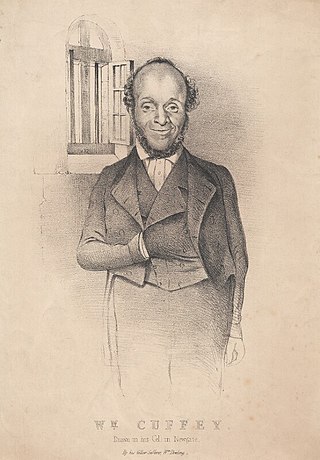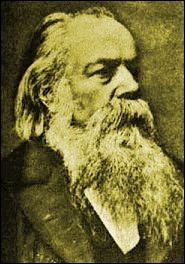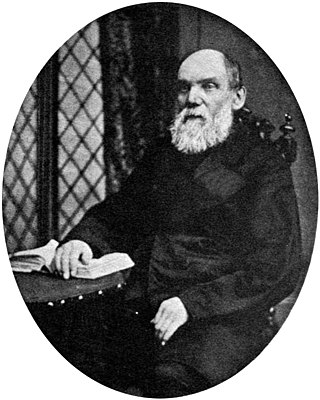
Chartism was a working-class movement for political reform in the United Kingdom that erupted from 1838 to 1857 and was strongest in 1839, 1842 and 1848. It took its name from the People's Charter of 1838 and was a national protest movement, with particular strongholds of support in Northern England, the East Midlands, the Staffordshire Potteries, the Black Country and the South Wales Valleys, where working people depended on single industries and were subject to wild swings in economic activity. Chartism was less strong in places, such as Bristol, that had more diversified economies. The movement was fiercely opposed by government authorities, who finally suppressed it.

Stalybridge is a town in Tameside, Greater Manchester, England, with a population of 23,731 at the 2011 Census.

Feargus Edward O'Connor was an Irish Chartist leader and advocate of the Land Plan, which sought to provide smallholdings for the labouring classes. A highly charismatic figure, O'Connor was admired for his energy and oratory, but was criticised for alleged egotism. His newspaper Northern Star (1837–1852) was widely read among workers, becoming the voice of the Chartist movement.

The Representation of the People Act 1867, known as the Reform Act 1867 or the Second Reform Act, is an Act of the British Parliament that enfranchised part of the urban male working class in England and Wales for the first time. It took effect in stages over the next two years, culminating in full commencement on 1 January 1869.

Joseph Sturge was an English Quaker, abolitionist and activist. He founded the British and Foreign Anti-Slavery Society. He worked throughout his life in Radical political actions supporting pacifism, working-class rights, and the universal emancipation of slaves. In the late 1830s, he published two books about the apprenticeship system in Jamaica, which helped persuade the British Parliament to adopt an earlier full emancipation date. In Jamaica, Sturge also helped found Free Villages with the Baptists, to provide living quarters for freed slaves; one was named Sturge Town in his memory.

Sybil, or The Two Nations is an 1845 novel by Benjamin Disraeli. Published in the same year as Friedrich Engels's The Condition of the Working Class in England in 1844, Sybil traces the plight of the working classes of England. Disraeli was interested in dealing with the horrific conditions in which the majority of England's working classes lived — or, what is generally called the Condition of England question.

William Cuffay was a Chartist leader in early Victorian London.

Samuel Holberry was a prominent Chartist activist.

Henry Vincent was active in the formation of early Working Men's Associations in Britain, a popular Chartist leader, brilliant and gifted public orator, prospective but ultimately unsuccessful Victorian member of parliament, and later an anti-slavery campaigner.

Robert George Gammage was a British surgeon and leading figure in Chartism in the 1830s and 1840s. He was also the author of the first history of the movement.

Stalybridge Mill, Stalybridge is a cotton spinning mill in Stalybridge, Tameside, Greater Manchester, England. It was built in 1868, and the engine reconfigured in around 1925. It was taken over by the Lancashire Cotton Corporation in the 1930s and passed to Courtaulds in 1964.
Predominantly centred on Hanley and Burslem, in what became the federation of Stoke-on-Trent, the 1842 Pottery Riots took place in the midst of the 1842 General Strike, and both are credited with helping to forge trade unionism and direct action as a powerful tool in British industrial relations.

The Preston Strike and Lune Street Riot, which took place in Preston, in Lancashire, England over 12 and 13 August 1842, were part of the 1842 General Strike or ‘Plug Plot Riots’. These strikes and disturbances were prompted by depression in 1841–1842 which resulted in wage cuts of over 25%.
Mortimer Grimshaw was an English political activist, strike leader and cotton weaver. He briefly attained national fame in the 1850s due to his part in the Preston strike of 1853–54. A large man whose face was marked by smallpox, he was renowned for his oratory, which earned him the nickname of the "Thunderer of Lancashire".

The Reform movement in Upper Canada was a political movement in British North America in the mid-19th century.
A general strike is a strike action in which participants cease all economic activity, such as working, to strengthen the bargaining position of a trade union or achieve a common social or political goal. They are organised by large coalitions of political, social, and labour organizations and may also include rallies, marches, boycotts, civil disobedience, non-payment of taxes, and other forms of direct or indirect action. Additionally, general strikes might exclude care workers, such as teachers, doctors, and nurses.
The labour movement or labor movement consists of two main wings: the trade union movement or labor union movement on the one hand, and the political labour movement on the other.
Jeremiah Yates was an active Chartist who served a one-year prison sentence for bringing workers out on strike during the 1842 Pottery Riots in England.
William Newton was a British trade unionist, journalist and Chartist.
Samuel Cook (1786–1861) lived in Dudley in the 19th century, where he promoted Radical political causes. He agitated for political reform, displaying political posters in the windows of his draper's shop. He became Chairman of the Dudley Political Union, which advocated parliamentary reform, and had a leading role in the Dudley Chartist movement. His political agitation resulted in him being put on trial on many occasions.













